Halloween 70 years ago
Old Field Nursery School Halloween Party 1949 (loaned from a private collection). The Old Field Nursery School was located in the school building next to the Old Field Club in East Setauket.
Photo submitted by Barbara Russell
Halloween 70 years ago
Old Field Nursery School Halloween Party 1949 (loaned from a private collection). The Old Field Nursery School was located in the school building next to the Old Field Club in East Setauket.
Photo submitted by Barbara Russell
By Kevin Redding
‘Lucky is the child who listens to a story from an elder and treasures it for years.’
— Barbara Russell,
Town of Brookhaven historian
Margo Arceri first heard about George Washington’s Setauket spies from her Strong’s Neck neighbor and local historian, Kate W. Strong, in the early 1970s. Arceri lights up when talking about her favorite spy, Anna Smith Strong.
“Kate W. Strong, Anna Smith Strong’s great-great-granddaughter, originally told me about the Culper Spy Ring when I used to visit her with my neighbor and Strong descendant Raymond Brewster Strong III. One of her stories was about Nancy (Anna Smith Strong’s nickname) and her magic clothesline. My love of history grew from there,” she said.
Six years ago Arceri approached the Three Village Historical Society’s President Steve Hintze and the board about conducting walking, biking and kayaking tours while sharing her knowledge of George Washington’s Long Island intelligence during the American Revolution.
Today, Arceri runs Tri-Spy Tours in the Three Village area, which follows in the actual footsteps of the Culper Spy Ring. “I wanted to target that 20- to 60-year-old active person,” she said. “I have to thank AMC’s miniseries ‘Turn’ because 80 percent of the people who sign up for the tour do so because of that show,” she laughs.
It was during one of those tours that Arceri came up with the idea of having a Culper Spy Day, a day to honor the members of Long Island’s brave Patriot spy ring who helped change the course of history and helped Washington win the Revolutionary War.
“Visiting places like the Brewster House, which is owned by The Ward Melville Heritage Organization, the grave site of genre artist William Sidney Mount at the Setauket Presbyterian Church cemetery (whose paintings are at The Long Island Museum) and the Country House, which was built in the 1700s,” Arceri thought “there has to be a day designated to celebrating all these organizations in the Three Villages and surrounding areas; where each of us can give our little piece of the story and that’s how Culper Spy Day developed.”
After a successful four-year run, the fifth annual Culper Spy Day will be held on Saturday, Sept. 14 from 9 a.m. to 4 p.m. offering self-guided tours of over 20 locations including the addition of the 42nd Royal Highland Regiment of Foot encampment with musket firing and battle drills on the Village Green for the ultimate Culper Spy Day experience. “The more the merrier,” laughs Arceri.
One of the highlights every year during the daylong dive into history is the opportunity to visit two neighboring and active churches in Setauket — the Caroline Church of Brookhaven and the Setauket Presbyterian Church, both on the National Register of Historic Places and prominent stomping grounds for soldiers and spies during the Revolutionary War. There will be docent-led tours through the historic structures and their premises, and visitors will be free to roam each church’s expansive cemetery, where some of the weathered gravestones stacked alongside each other belong to those who helped win our independence.
While the congregations have a good relationship these days, and together co-own and maintain the Setauket Village Green that separates the two sites, there was a time when the churches couldn’t have been more opposed. In fact, the conflict of the American Revolution was represented quite well, on a local front, by the two Setauket buildings.
Caroline Church of Brookhaven
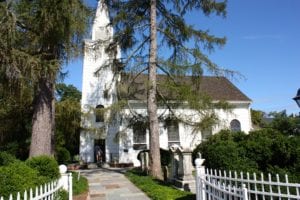
The Caroline Church’s congregation began in 1723 and was officially erected as a building six years later in 1729. Aside from some modern renovations, including the installation of colored glass windows around the interior of the church in the late 19th century, in terms of what it looked like during the war, “What you’re looking at was here,” Town of Brookhaven historian Barbara Russell tells church tourists when they inevitably ask upon enter the historic building.
“The original wood beams are still here,” said Russell, pointing out the hull-shaped ceiling of the beautiful and age-scented church. “I think it’s important to say that we’re still a church. Believe it or not, there are people who walk in here on Culper Spy Day thinking we’re just some kind of museum and we’re not. We value our historic building, but we’re still an active Episcopal congregation.”
“This is a special place,” Russell continued. “We’re coming up on the congregation’s 300th anniversary. Our country isn’t even that old yet!” According to the town historian, the Episcopalian church was an Anglican one before the Revolution, and was the house of worship for Loyalists in the area, those American colonists who remained supportive of the British crown during the fighting.
In fact, the original congregation’s staunch loyalty to Britain gave the building its current name. It was originally Christ Church, but, according to Russell, it is alleged that someone wrote to Queen Wilhelmina Karoline of Brandenburgh-Anspach, queen of George II throughout the early 18th century, informing her of the church when it was brand new, compelling her highness to send its members a silver communion service.
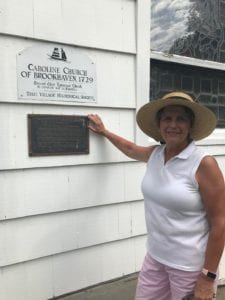
Although Russell said the royal gift is nowhere to be found within the church, there are Vestry minutes that record the unanimous decision “…that this Church and parish Shall in honour of our gracious Queen, her most Serene Britannic Majesty be hereafter called Caroline parish and Caroline Church, and this be entered upon record in Our Vestry books ad futuram rei Memoriam.”
A portrait of the queen hangs on the wall of the church’s lobby, on the left side when you enter. Also in that first room, encased in plexiglass, is a musket ball that was found embedded in a wall near the building’s southwest corner when the church was being restored by philanthropist Ward Melville in 1937. Assumed to be a remnant of the Raid of Setauket in 1777, the single, approximately 69-caliber projectile was, according to historians at the site, most likely fired from an American soldier’s French musket during the raid.
“It was either somebody firing at the church steeple or a soldier that didn’t have very good aim,” Russell laughed.
Among the gravestones in the church’s cemetery is one for Mary Longbotham Muirson, wife of Dr. George Muirson, a Setauket resident, physician, Loyalist and worshipper at the church. Although he was a medical doctor, Dr. Muirson was not welcome to stay in the town after the war due to his Loyalist beliefs; his lands were confiscated and he was banished. It’s not clear what happened to Mary Muirson, but there’s a letter that was sent to her from her husband in April 1784, so it’s most likely that she remained in Setauket.
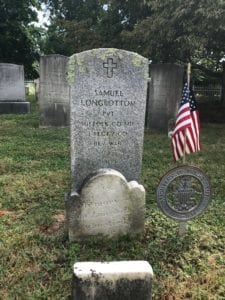
Most interestingly, Muirson’s son, Heathcote Muirson, from a previous marriage, fought on the Patriot side; he took part in the raid on Fort St. George in Mastic in 1780 under the command of Col. Benjamin Tallmadge — of course, East Setauket’s most famous hero and leader of the Culper Spy Ring — and ultimately died from wounds suffered at Lloyd Neck. Muirson’s other son was a Loyalist.
“So there was a father and son on either side of the conflict. We saw that happen again and again, right?” Russell observed, overlooking the gravestones that include Revolutionary War veterans and Suffolk County Militia soldiers.
Russell said there are a total of six Patriot graves in the Caroline churchyard including Israel Bennett, Robert Jayne, Samuel Jayne, Benjamin Jones, Vincent Jones and Samuel Longbottom, all of which can be visited on Culper Spy Day. Participants are encouraged to walk through and explore the area on their own. However, docents will be in the church and in the church’s History Center on the lower level of the Parish House for tours and to answer questions.
Setauket Presbyterian Church
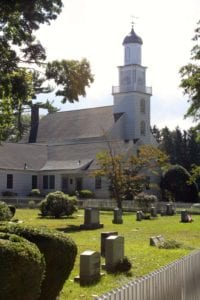
High among the list of helpful experts on the premises is Art Billadello, a longtime member and past president of the Three Village Historical Society and the Setauket Presbyterian Church’s go-to representative. He’s been a member of the congregation since 1986 and, for more than 30 years, Billadello has taken great pride in preserving and sharing the history of the Federal-style church — as well as debunking any and all myths that surround it, of which there have been plenty.
Many of these falsities can be linked to “TURN,” which has been a blessing and a curse for the site, according to Billadello.
“When that [mini-series] was running, if I had 30 people on a Revolutionary History Walking Tour, the first thing I’d ask as soon as they got out of their cars was, ‘How many of you watched ‘TURN’?’,” Billadello recalls. “Out of those 30 people, 20 hands would go up. Then the second thing I’ll say to them is, ‘Well, I’m gonna turn you around 180 degrees to the truth …’ because they would believe everything on the show, which isn’t all accurate … that’s Hollywood.”
Despite letting down some faithful viewers of the AMC program by dispelling the “sexier” and more fabricated aspects of the show in favor of what really happened, Billadello agrees with Arceri that “TURN” has been beneficial by bringing hordes of visitors from all over to the church.
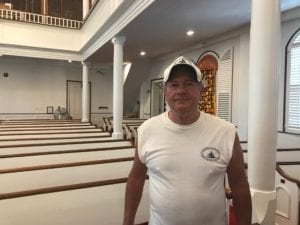
The truth is, the Presbyterian Church that stands at 5 Caroline Avenue today is not the one that was there during the American Revolution. “The new church,” as Billadello calls it, is at least the third structure on the site. The Revolutionary-Era Church, built circa 1714, looked more like the Caroline Church. It was destroyed and fortified in 1777 by the Loyalists who worshipped across the street and looked down on the Presbyterian, a congregation that was occupied by supporters of America’s independence.
In fact, Benjamin Tallmadge’s father was a pastor at the church from 1754 — the year of Tallmadge’s birth — until he died in 1786. His father and mother are among those buried in the church’s graveyard, along with Abraham Woodhull, another leading member of the Culper Spy Ring, whose commemorative monument is one of the most impressive on the property.
Arceri’s hero, Anna Smith Strong, is buried in the neighboring St. Georges Manor Cemetery in Strong’s Neck. According to Billadello, she once used her Loyalist connections to get her husband, Selah Strong, released from the prison ship where he was confined. The two lived in Setauket for the duration of their lives following the war.
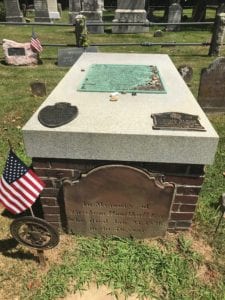 “This history is so important because it was ordinary civilians, from this town, doing extraordinary things,” Billadello said. “All school kids know about George Washington, but these regular people who helped win our independence are virtually unknown.”
“This history is so important because it was ordinary civilians, from this town, doing extraordinary things,” Billadello said. “All school kids know about George Washington, but these regular people who helped win our independence are virtually unknown.”
Indeed, Woodhull was a farmer and Caleb Brewster was a blacksmith while Austin Roe was a tavernkeeper. “They could’ve been caught and hung,” explained Billadello.
The Presbyterian Church was built back up around 1781, but in 1811, it was struck by lightning and most of it burned down as a result. The structurally sound beams, which were exposed to the fire and appear charred, were re-used in the steeple of the church and remain on the property.
By the end of 1811, the church was rebuilt for a third time and was officially dedicated in the spring of the following year. While, as in the case of the Caroline Church, there have been some modern renovations of its interior, like carpeting, rail and pew replacements, the Presbyterian Church is irrefutably historic inside. There’s even a pew door from 1811 on display.
During Culper Spy Day, docents will be on hand to give tours of the historic church and cemetery.
Arceri’s favorite part of the day is “seeing all these different organizations coming together as a whole. It really is our Revolutionary story,” she said. “Everywhere you turn in the Three Villages you are looking at an artifact, and as the historical society believes, the community is our museum and I would really love to put that on the forefront of people’s minds.”
Tickets are $25 adults, $5 children ages 6 to 12 and may be purchased in advance at the Three Village Historical Society (TVHS), 93 North Country Road, Setauket, by calling 631-751-3730 or by visiting www.tvhs.org. Veterans and children under the age of 6 are free.
Tickets may be picked up at the TVHS from Sept. 10 to 14. At that time, participants will receive a bracelet and a copy of the Culper Spy Day map with all event listings and include access to 21 Culper Spy Ring locations. If available, tickets may be purchased at the historical society on the day of the event.
Participating organizations:
The fifth annual Culper Spy Day is presented by Tri-Spy Tours, the Three Village Historical Society, The Long Island Museum and The Ward Melville Heritage Organization in collaboration with The Benjamin Tallmadge District of the Boy Scouts, Brewster House, Campus Bicycle, Caroline Church of Brookhaven, Country House Restaurant, Custom House, Daughters of the American Revolution Anna Smith Strong Chapter, Discover Long Island, 1750 David Conklin Farmhouse Museum, 1795 Dr. Daniel Kissam House Museum, Drowned Meadow Cottage Museum, Incorporated Village of Port Jefferson, East Hampton Library, Long Island Collection, Emma S. Clark Memorial Library, Fairfield Historical Society, Fairfield Museum & History Center, Frank Melville Memorial Park, Fraunces Tavern Museum, Gallery North, History Close at Hand, Huntington Historical Society, Joseph Lloyd Manor House, Ketcham Inn Foundation, Litchfield Historical Society, Old Methodist Church, Paumanok Tours, Preservation Long Island, Raynham Hall Museum, Rock Hall Museum, 42nd Royal Highland Regiment of Foot, Setauket Elementary School, Setauket Harbor Task Force, Setauket Neighborhood House, Setauket Presbyterian Church, Sherwood-Jayne Farm, Special Collections Stony Brook University Libraries, Stirring up History, Stony Brook Grist Mill, Three Village Community Trust, The Three Village Inn, The Thompson House, Times Beacon Record News Media and the Underhill Society of America.
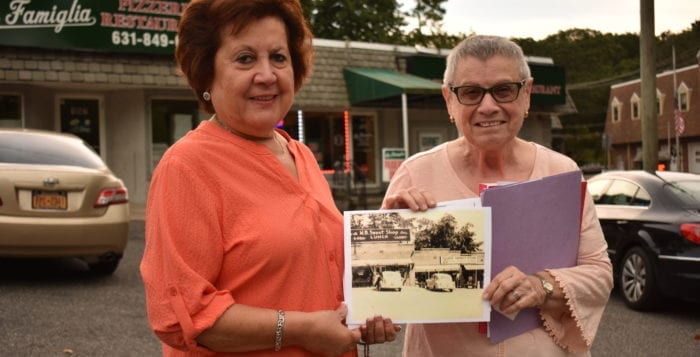
Ninety years ago in 1929, New York City newspaper The Daily Mirror offered subscribers the opportunity to buy a 20- by 100-foot parcel of undeveloped land between Rocky Point and Miller Place. The cost to purchase a plot of land through the subscription was $89.50 in 1929, equivalent to $1,315 in 2019.
In the trees and rocks of Long Island’s North Shore, a hamlet slowly rose from the earth.
Sound Beach is a hamlet of only 1.6 square miles and around 7,612 people, according to the last census. Stuffed in between Rocky Point and Miller Place, one of the North Shore’s smallest hamlets barely scrapes along the ubiquitously driven Route 25A. For those who don’t know the area, the hamlet boundaries are often mistaken for that of its neighbors.
Rocky Point has a historical society. So does Miller Place, combined with bordering Mount Sinai. Now prominent members of the Sound Beach community feel that’s something that needs correcting.

Mimi Hodges, a near lifelong resident, is just one of the several women who are looking at Sound Beach’s past. She said that ad in the newspaper didn’t attract your average vacationers looking to take a break from New York City. They were working-class individuals, all of whom were looking for a change of pace during the depression era of the 1930s. They came with very little, sometimes only tents for their families, but still managed to build a small but safe town.
“Sound Beach is unique in that it was a place created specifically for the working class,” she said. “People who didn’t have a lot of money and wanted to get away from the city — from Brooklyn and Queens. They put up their tents, they put up their own little houses, and eventually, in 1930, the Sound Beach Property Owner’s Association was born.”
The Sound Beach history project, which is being spearheaded by the Sound Beach Civic Association, is hoping to bridge that gap. Engineered by community leaders and longtime residents, local women are already uncovering several old photographs that show a much different Sound Beach, full of dirt roads and dusty buildings.
“It’s like a little mystery,” said Sound Beach Civic Association President Bea Ruberto.
Vilma Rodriguez, another resident, said work comes in bits and pieces, but their group has been energized.
“Sound Beach had no roads, no streetlights,” she said referring to the olden days of the small hamlet. “It’s little bits of information, but it builds up.”
For many of its earliest decades, mail was sent and received through Scotty’s General Store on Echo Avenue or Moeller’s General Store on Sound Beach Boulevard. It wasn’t until June 1, 1946, the first post office opened in the hamlet.
In the small shopping center off of New York Avenue, where La Famiglia Pizzeria currently resides, the locals used to go to M.B. Sweet Shop for lunch and candy. Next to it, instead of the Italian restaurant, was the Square Market Store. Local resident Florence McArdle attributed the local setting to a particular show.
“It was just like ‘Happy Days,’” she said.
Back in the day, the building that now houses Bedrossian Real Estate on Northport Road once was a community house that hosted everything from dances to pingpong and knock hockey. In that time, lacking a church, McArdle, a resident from the 1930s, said local community members “would iron the tablecloth, flip it over and they would have Mass on Sundays in the bar, Boyles.”
Sound Beach once had its own police department, its own highway and sanitation department. People once gathered at the “pavilion” on the bluff, where kids could buy ice cream and hot dogs.
Local resident Stephanie Mcllvaine said she has been pouring through newsletters from the 1940s, which reveal just how much has changed in the 80 years since. She wrote that a May 1940 newsletter was the census results. John Mertz, the winter caretaker and “mayor,” found 61 families consisting of 185 people lived in Sound Beach year-round. There were four general stores, three gas stations, one restaurant, five general contractors, two masons, one electrician, two fire wardens and two deputy sheriffs. Many of the year-round residents were members of the fire department as well.
Despite their deep dive into this local history, many things are still unknown. What locals call “The Square” was either called Journal Square or Moeller Square, though Ruberto did not know where Journal Square even came from. There was a Moeller of the general store fame, but she has had trouble getting in contact with the family. She learned there was a James Moeller who taught math at the Miller Place School District but learned from the board of education he passed in 2012.
Barbara Russell, the Town of Brookhaven historian, said her office has only a few items and details in the way of Sound Beach, but she praised the women for taking on the task. She said with the enthusiasm the group is showing, they’re well on their way to creating walking tours or a historical society.
Many of the local women looking back at the hamlet’s history have a fondness for the way things were. They watched the area grow slowly, ever so slowly, from the working-class family’s retreat to what it is today. Back then, Sound Beach was the destination, and there was no need to drive out and plan visits to other parts of the island, they said.
“Most of us here, we thought we were growing up in a ‘garden of Eden,’” said Hodges. “It was just fantastic.”
For those looking to get involved in the history project or who are interested in donating old photos, contact Bea Ruberto at [email protected] or call 631-744-6952.
The Carriage Shed at the Caroline Church of Brookhaven continues to receive a makeover.
The Robert David Lion Gardiner Foundation announced Jan. 11 it had recently awarded the church a matching grant of $10,950. The grant is to cover the cost of replacing the cedar roof on the shed, and according to Barbara Russell, a junior warden at the church and Town of Brookhaven historian, work has already started on the roof as Jan. 15.
The grant marks the second time in the last two years the church has received funds from the foundation. The first matching grant of $23,700 was awarded in 2017 and was used to help stabilize the shed, which was built in 1887. The shed’s internal framework needed replacing as the supporting locust poles were sinking into the ground, according to Russell.
The historian said the congregation was grateful to the foundation for its help.
“Our shared commitment to telling the story of our rich heritage of our communities is exemplified in our ongoing collaboration,” Russell said. “We look forward to the full restoration of the shed in time for our [upcoming] anniversary celebration.”
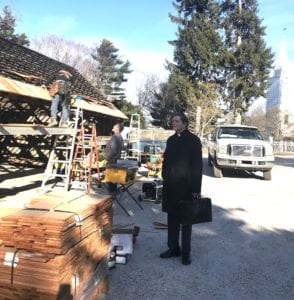
Kathryn Curran, executive director of the Gardiner foundation, called the shed “an icon to the community.” When a nonprofit like the Caroline Church applies for a matching grant from the foundation, she said, they must have the full funding match in place. She added two-part projects like the shed are not unusual.
“There are times when an organization needs to break the project into doable funded portions,” she said. “When a RDLGF grant is awarded, an applicant must complete that first contracted grant and have their final report accepted by the foundation before another application will be reviewed. The Caroline Church applied for two separate grants in two years to complete this project.”
Located on the east side of Bates Road on the church’s property, the Carriage Shed is one of four contributing structures to the church being on the National Register of Historic Places. The shed was initially intended for members to park their carriages while attending services and in later years was used for parishioners to park their cars.
The Caroline Church celebrates its 296th anniversary later this month. Russell said the congregation will commemorate the milestone at their 9:30 a.m. service Jan. 27, and an event to celebrate the restored shed will be held at a later date.
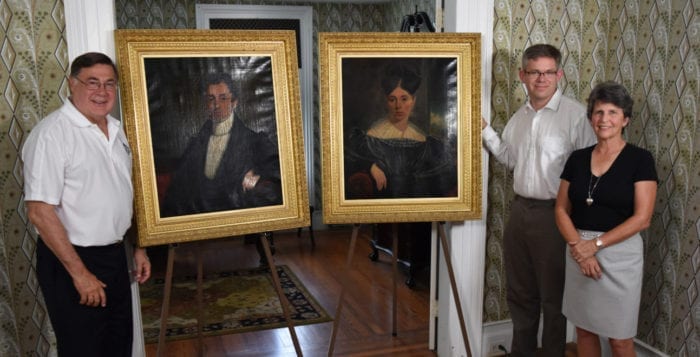
On Aug. 7, Town of Brookhaven Supervisor Ed Romaine (R) and town historian Barbara Russell visited the Longwood Estate (circa 1790) in Ridge where they presented two historic paintings to Joshua Ruff, director of collections and interpretation at The Long Island Museum in Stony Brook, to be added to the museum’s collection as a long-term loan.
The portraits, painted by Shepard Alonzo Mount, were gifted to the town by Eleanor Smith of California. The subjects are William Sidney Smith (1796–1879) and his wife, Eleanor Jones Smith (1805–1884). A year after their marriage in 1823, the couple came to Longwood Estate and raised 10 children. William Smith served as Brookhaven Supervisor from 1829 to 1834.
“These pieces were donated to the Town of Brookhaven, they still belong to the Town of Brookhaven, but they are coming to the museum and will be stored in our collections to be used occasionally for exhibition purposes,” said Ruff in a recent phone interview. “We agreed in taking them as a long-term loan because we believe they really add to our holdings on Shepard Alonzo Mount.”
Painted in the early 1830s, the two portraits were displayed in the house on the property until the last Smith family owner, Eleanor Northrup Smith, sold the estate and moved to California in the late 1960s. The paintings have been stored in a warehouse since that time.
Albeit a loan, Ruff is thrilled to be able to add them to the museum’s current collection, which includes more than 25 of Shepard Alonzo Mount’s paintings and several hundred of his drawings and sketches, not to mention the enormous collection of paintings and drawings by his more famous younger brother, William Sidney Mount.
According to Ruff, these particular portraits are unique in that they precede the portrait paintings the museum has, which are from the later 1830s and 1840s. “They were done just when [Shepard] was starting to launch his career as a portrait artist. This was a phase of his career that we hadn’t really documented before. They are valuable in that sense to us,” he said. “They show him beginning to mature as an artist and improve in his skills.”
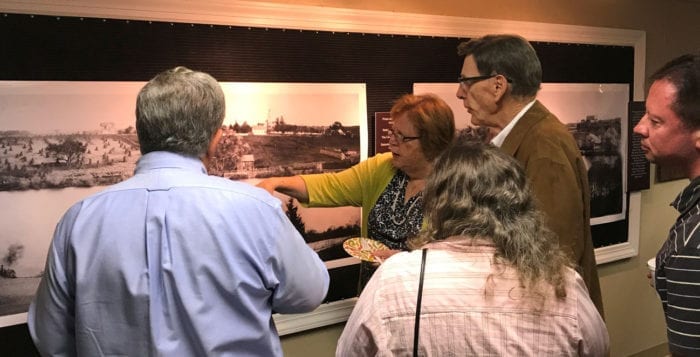
By Beverly C. Tyler
A new exhibit, “The 1800s, Growth and Change: The Church, The Community, The Country,” will be open to the public Oct. 7 through 9 from 1 to 4 p.m. in the history center of Caroline Church of Brookhaven, located at 1 Dyke Road, Setauket.
The exhibit details how Caroline Church recovered and prospered following the decades after the Revolutionary War. It also features the 1887 Caroline Church carriage shed which is one of the structures listed along with the church on the National Register of Historic Places in America and is currently being restored to its original state.
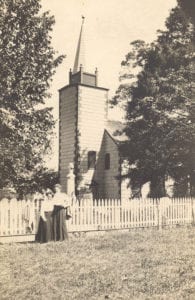
The exhibit section on the community illustrates, on various panels, how the Three Village area moved from an agricultural base to an industrial community with shipbuilding, a piano factory, a rubber factory and other industries. Featured photographs in the exhibit include two 4-foot long overlapping images of the Setauket area photographed on site in 1878 by George Bradford Brainerd (1845-1887). The photos, taken when there were few trees to hide the view, show the entire area from the Setauket Mill Pond to Route 25A. A series of questions then asks the viewer to identify various structures. Barbara Russell, Brookhaven Town historian and a member of the Caroline Church Historical Commission said, “We thought it would be more interesting to give a background on the photos, and then let the viewer find things, rather than point everything out.”
The section on the country features women’s work in both home and community, some of the local effects of the Civil War, the expansion of the public school system and other events that defined community life in the 19th century.
The exhibit opening is scheduled as part of New York State’s Path Through History weekends, when many events are scheduled to celebrate the state’s rich heritage. In addition to the exhibit at the 1729 Caroline Church, the Three Village Historical Society walking tour “Abraham Woodhull: Farmer and Revolutionary War Spy” will be held on Saturday, Oct. 7, starting at 2 p.m. from the Caroline Church front parking lot. The tour will include locations where the Revolutionary War Culper Spy Ring operated.
Beverly Tyler is Three Village Historical Society historian and author of books available from the society at 93 North Country Road, Setauket. For more information, call 631-751-3730 or visit www.tvhs.org.
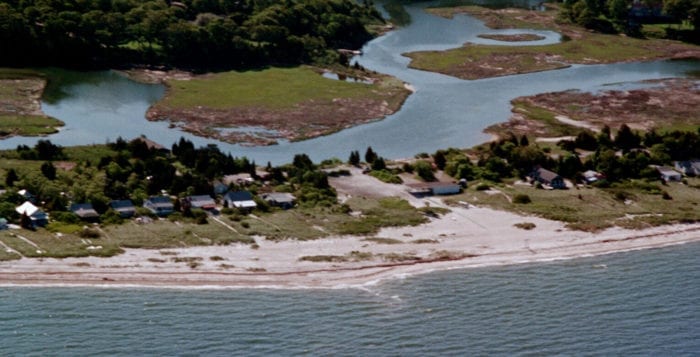
By Beverly C. Tyler
From Native American hunter-gatherers through Colonial times, West Meadow Beach, West Meadow Creek and the adjacent tidal wetlands were a valuable resource.
On Saturday, July 16, an historic walk will be conducted by Barbara Russell, historian, Town of Brookhaven, and Beverly Tyler, historian, Three Village Historical Society. The walk, along Trustees Road from the pavilion at West Meadow Beach to the Gamecock Cottage, is sponsored by the Town of Brookhaven and cosponsored by the Three Village Historical Society.
Come and explore the area that sustained Native Americans and provided needed materials for settlers from the Colonial period to the present day. The walk is free and open to the public. No pre-registration required, however be on time as the walk will commence at 10:30 a.m. sharp. An exhibit in the Gamecock Cottage at the end of the walk will include artifacts gathered from the West Meadow Creek area.
We don’t know all the details about life on Long Island before the Europeans came because the people living here did not leave us a written or photographic record of their lives.
Archaeological excavations have given us most of the details of how people lived in this area as early as 5,000 years ago. One of the most famous sites in New York State was a nearby shell midden named The Stony Brook Site, excavated by State Archaeologist William Ritchie in 1955.
From archaeological digs by Ritchie and others, we know that, between 5,000 and 3,000 years ago, the native people were hunters and gatherers, dependent upon hunting local animals and gathering plants, stones, and clay for food, shelter, tools, clothes, and medicines.
The Fischetti Site, a prehistoric Indian site for manufacturing tools and spear points, was discovered during a cultural resource investigation of a proposed residential development in November 1980. Salvage excavations continued through October 1981.
The site, on the east side of West Meadow Creek, opposite the horse show grounds, was occupied by Algonquin Indians about 3,000 years ago. We know they used this location then because of the type of arrow and spear points and blades recovered. The major activity here, on the edge of Stony Brook creek, was making stone tools. We know this by the large quantities of stone flakes and roughed-out stones.
The almost total absence of food remains at the site shows that this was not the location of a village. However, a village site, The Stony Brook Site, did exist about 800 yards to the south, along what is now known as Aunt Amy’s Creek, during the same time period.
For thousands of years the Indians used natural resources, wood, stone, and animals, to make their housing, tools, and clothing. About 3,000 years ago, their way of life changed with the introduction of three things: pottery, the bow and arrow, and horticulture (farming). Like the earlier Indians, the Woodland Indians continued to rely on natural resources.
The artifacts taken from The Fischetti Site are part of the collection of the Three Village Historical Society. Artifacts from the Ritchie site are a part of the collection of the New York State Museum.
Beverly Tyler is the Three Village Historical Society historian and author of books available from the Three Village Historical Society.
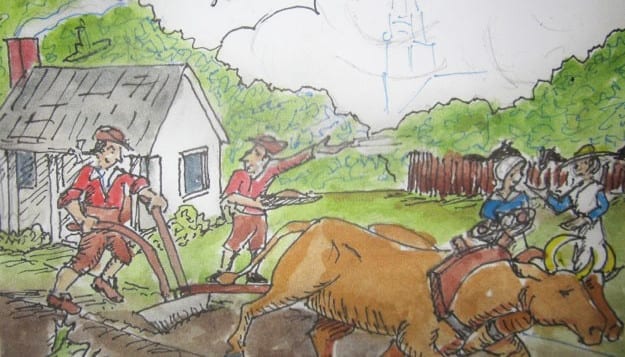
By Barbara M. Russell
The Caroline Church of Brookhaven (Episcopal), One Dyke Road, Setauket, recently unveiled a new exhibit in its History Center.
Titled “Caroline Church in the 1700s,” it is the third exhibit curated by the Historical and Cultural Arts Commission. A self-guided tour takes the visitor through five areas illustrating the church and the community in the 18th century: Settler, Missionary, Clergy, Builder and Patriot/Loyalist. The narrative and artifacts presented in each area assist the viewer to understand the church’s role in a new and growing community.
A feature of the exhibit is a whimsical frog, which greets visitors at the start, and reappears, in colorful illustrations by artist John Rhein.
The Society for the Propagation of the Gospel in Foreign Parts brought Anglican missionaries to Long Island and by 1723, a congregation was formed in Setauket. Five clergy are highlighted in the exhibit; those who led the congregation from its inception, to the building of the church in 1729, through the American Revolution, and into the next century. Some architectural artifacts are on display including a round-top door and early nails.
The Patriot/Loyalist section includes biographies of two parishioners, Dr. George Muirson and his son, Heathcote. Dr Muirson, a local physician, was an ardent Loyalist, and his son, a Patriot. Also featured within the Patriot/Loyalist section is local resident, Benjamin Floyd. The viewer can decide which “side” he favored.
Two permanent exhibits, a timeline of Caroline Church and the Rector’s Gallery can also be seen.
The History Center is located in the lower level of the Parish House and is open Sundays from 8 a.m. to noon. Arrangements can be made to view the exhibit at other times by calling the Parish Office at 631-941-4245.
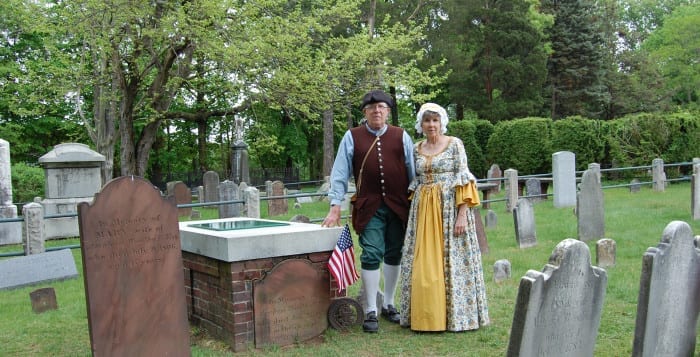
By Barbara Russell
“By the 29th inst I expect to hear further from C_; his Dispatches shall be duly forwarded I would take the liberty to observe that a safe conveyance may be had, by the bearer, for the ink which your Excellency proposed sending to C_”
The writer was Setauket native Col. Benjamin Tallmadge, and the letter was sent to General George Washington July 25, 1779. Tallmadge is assuring the general that he is expecting information soon from C_, alias Samuel Culper, alias Abraham Woodhull, and is referring to an invisible ink provided by Washington to be used by members of the Culper Spy Ring.
Born in Setauket in 1754, Benjamin Tallmadge left Setauket as a teenager to enter Yale College, became a school teacher after graduation, and subsequently joined the Patriot forces. He served as the chief intelligence officer for General George Washington and relied on his childhood friends from Setauket for the intelligence reports so vital to Washington’s success.
The Culper Spy Ring is not a tale but a real and factual account of spying during the American Revolution. Its epicenter was nestled right here in Setauket. Benjamin Tallmadge, Abraham Woodhull, Austin Roe and Caleb Brewster all lived here and knew each other growing up. Tallmadge leaned on his trusted friends to create the web that brought information from New York City out to Long Island and across the Long Island Sound to him in Connecticut. From there, it was transmitted to General Washington.
Spying is very risky, and every person involved knew it. All but Caleb Brewster used fictitious names; invisible ink was provided; a dictionary of code words invented; and success depended on trusting that each person was committed to the fullest. The Culper Spy Ring operated from 1778 through 1783, with additional agents beyond the Setauket friends. One known agent was Robert Townsend of Oyster Bay, who had a business in New York City, allowing him to pick up information on British troop strengths and movements and then pass it on to either Austin Roe, an innkeeper, or Abraham Woodhull, a farmer and business operator. Both traveled to New York City in the course of their businesses.
The residents of Brookhaven attempted to carry on with their lives, while British soldiers were assigned to the Setauket area, following the disastrous Battle of Long Island in August 1776. Town board minutes of the time do not refer to the war but to the general running of a municipality with tax collecting, electing officials, land ownership, and responsibility for the indigent. Newspapers of the time did report unpleasant raids and indignities imposed on the residents. In December 1776, William Tryon, provincial governor of New York, traveled to Setauket to secure the support of Brookhaven residents for his majesty’s government.
Eight hundred one men pledged their support for the British Crown on the Setauket Village Green, then Brookhaven’s central meeting place. Among the signers was Abraham Woodhull, perhaps a move that would reduce suspicion for his intelligence work. Some residents, who feared for their safety, did flee to Connecticut, and remained for the duration of the war. Those who stayed were subjected to British occupation, often having soldiers billeted in their homes, and their livestock and crops seized for use by the British.
Woodhull and Roe continued to live in Setauket throughout the war years, settling into their occupations and carrying on their intelligence work, probably not without fear of being discovered. Brewster, a determined and fearless man, made many trips across Long Island Sound to support the Patriot cause but never returned to Setauket to live. Tallmadge owed the success of his intelligence work to his friends and likely to others whose names are still unknown or unconfirmed.
Although the information about the Culpers was publicized over 80 years ago by former Suffolk County historian, Morton Pennypacker, it has received national attention in the last 10 years. Its rightful place among the history of the American Revolution was aided by the publication of “Washington’s Spies: The Story of America’s First Spy Ring” by Alexander Rose in 2006, “George Washington’s Secret Six: The Spy Ring That Saved the American Revolution” by Brian Kilmeade and Don Yaeger in 2013 and the AMC series “TURN,” now in its second season. And it all happened here.
Lucky is the child who listens to a story from an elder and cherishes it for years. Margo Arceri first heard the Culper Spy Ring story from her Strong’s Neck neighbor and local historian, Kate W. Strong in the 1970s.
“Kate W. Strong, Anna Smith Strong’s great-great-grandaughter, originally told me this story as a child when I used to visit her with my neighbor and Strong descendant Raymond Brewster Strong lll,” said Arceri. “She wrote for The Long Island Forum ‘The True Tales of the Early Days on Long Island.’ One of her stories was about Nancy [Anna Smith Strong’s nickname} and her magic clothesline. That’s where I first heard about the Spy Ring and my love grew from there.”
Today Arceri runs Tri-Spy Tours to share her knowledge of George Washington’s Long Island intelligence during the American Revolution. Her perseverance has inspired the upcoming Culper Spy Day — Our Revolutionary Story, on Saturday, June 20.
Barbara Russell is the Town of Brookhaven’s historian.
